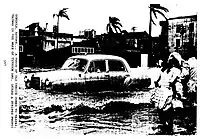| Category 5 super typhoon (SSHWS) | |
 Image of Typhoon Amy on August 31, 1962 | |
| Formed | August 28, 1962 |
|---|---|
| Dissipated | September 7, 1962 |
| Highest winds | 1-minute sustained: 260 km/h (160 mph) |
| Lowest pressure | 940 hPa (mbar); 27.76 inHg |
| Fatalities | 24 |
| Damage | Millions |
| Areas affected | Taiwan, China, North Korea, South Korea |
| Part of the 1962 Pacific typhoon season | |
Typhoon Amy was a super typhoon formed in August and September 1962. Amy made landfall in Taiwan as a category 4 equivalent super typhoon, then in China as a typhoon, moved out into the South China Sea, and finally made landfall in South Korea as a tropical storm.
Meteorological history

The precursor to Typhoon Amy formed on August 27 northwest of Truk as a surge from the westerlies. The system rapidly gained strength in the open waters of the Pacific Ocean, gaining enough winds to be declared a tropical depression on the morning of August 29. The depression rapidly intensified, becoming a tropical storm within six hours. Now named Amy, the cyclone bent northeast around Saipan with winds of 70 mph (110 km/h). After passing Saipan, Amy strengthened into a typhoon during the afternoon of August 30. Continuing to rapidly strengthen over water, Amy reached its peak wind speed of 160 mph (260 km/h) on the evening of September 1, far to the northeast of the Philippines. After peaking with a pressure of 935 millibars, the typhoon weakened back to 155 mph (249 km/h) and soon 150 mph (240 km/h), which it sustained for several days.[1] Crossing to the northeast of Luzon, Amy maintained strength, rapidly approaching the island of Taiwan on September 4. The storm slowly weakened to a 115 mph (185 km/h) typhoon off the coast of Taiwan, making landfall on September 5 near the city of Yilan City. Amy weakened over land slightly before making landfall near Fuzhou later that day. Amy crossed over mainland China for several days, slowly weakening into a minimal tropical storm before crossing back into the waters of the East China Sea near Yancheng. Amy strengthened back to winds of 45 mph (72 km/h) before weakening into a tropical depression off the coast of South Korea. The depression made landfall near Incheon on September 7, weakening over land. After crossing out into open waters, the remains of Amy became extratropical on September 8, affected by the cold air.[2] The extratropical remains of Amy continued northeast along the North Korean mainland, crossing the island of Sakhalin on September 9. The remains of Amy were lost off the eastern coast of Sakhalin on September 10, west of the Kamchatka Peninsula.[3]
Impact

Amy's flooding killed 24 people, with millions of dollars in damage, power, communication lines and buildings.[4]
See also
- Typhoon Opal (1962) - took a similar track a month earlier
References
- ↑ "Annual Tropical Cyclone Report – 1962" (PDF). Pearl Harbor, Hawaii: Joint Typhoon Warning Center. 1962. Retrieved November 30, 2008.
- ↑ "Annual Tropical Cyclone Report – 1962" (PDF). Pearl Harbor, Hawaii: Joint Typhoon Warning Center. 1962. Retrieved November 30, 2008.
- ↑ "RSMC Best Track Data (Graphics) in 1962". Tokyo, Japan: Japan Meteorological Agency. 1962. Archived from the original on May 23, 2011. Retrieved April 27, 2011.
- ↑ "Annual Tropical Cyclone Report – 1962" (PDF). Pearl Harbor, Hawaii: Joint Typhoon Warning Center. 1962. Retrieved November 30, 2008.
External links
- Typhoon 'amy' Hits Formosa (1962) – YouTube
- 1962 Typhoon Amy Hits Taiwan – YouTube
- Digital Typhoon : Typhoon 196217 (AMY) – National Institute of Informatics
